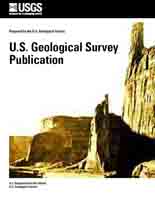 Background
Background
A zone of deep-water reefs is thought to extend from the mid and outer shelf south of Mississippi and Alabama to at least the northwestern Florida shelf off Panama City, Florida (Figure 1, 67kb). The reefs off Mississippi and Alabama are found in water depths of 60 to 120 m (Ludwick and Walton, 1957; Gardner et al., in press) and were the focus of a multibeam echosounder (MBES) mapping survey by the U.S. Geological Survey (USGS) in 2000 (Gardner et al., 2000; in press). If this deep-water-reef trend does exist along the northwestern Florida shelf, then it is critical to determine the accurate geomorphology and type of the reefs that occur because of their importance as benthic habitats for fisheries.
Precisely georeferenced high-resolution mapping of bathymetry is a fundamental first step in the study of areas suspected to be critical habitats. Morphology is thought to be critical to defining the distribution of dominant demersal plankton/planktivores communities. Fish faunas of shallow hermatypic reefs have been well studied, but those of deep ahermatypic reefs have been relatively ignored. The ecology of deep-water ahermatypic reefs is fundamentally different from hermatypic reefs because autochthonous intracellular symbiotic zooxanthellae (the carbon source for hermatypic corals) do not form the base of the trophic web in ahermatypic reefs. Instead, exogenous plankton, transported to the reef by currents, serves as the primary carbon source. Thus, one of the principle uses of the morphology data will be to identify whether any reefs found are hermatypic or ahermatypic in origin.
Community structure and trophodynamics of demersal fishes of the outer continental of the northeastern Gulf of Mexico presently are the focus of a major USGS reseach project. A goal of the project is to answer questions concerning the relative roles played by morphology and surficial geology in controling biological differentiation. Deep-water reefs are important because they are fish havens, key spawning sites, and are critical early larval and juvenile habitats for economically important sport/food fishes. It is known that deep-water reefs function as a key source for re-population (via seasonal and ontogenetic migration) of heavily impacted inshore reefs.
The deep-water reefs south of Mississippi and Alabama support a lush fauna of ahermatypic hard corals, soft corals, black corals, sessile crinoids and sponges, that together form a living habitat for a well-developed fish fauna. The fish fauna comprises typical Caribbean reef fishes and Carolinian shelf fishes, plus epipelagic fishes, and a few deep-sea fishes. The base of the megafaunal invertebrate food web is plankton, borne by essentially continuous semi-laminar currents generated by eddies, spawned off the Loop Current, that periodically travel across the shelf edge.
A few, sidescan-sonar surveys have been made of areas locally identified as Destin Pinnacles, Steamboat Lumps Marine Reserve (Koenig et al., 2000; Scanlon, et al., 2000; 2001), Twin Ridges (Briere, et al., 2000; Scanlon, et al., 2000), and Madison-Swanson Marine Reserve (Koenig et al., 2000; Scanlon, et al., 2000; 2001). However, no quantitative and little qualitative information about the geomorphology and surficial geology can be gained from these data. Existing bathymetry along the northwestern Florida shelf suggests the existence of areas of possible isolated deep-water reefs. NOAA bathymetric maps NOS NH16-9 and NG16-12 show geomorphic expressions that hint of the presence of reefs in isolated areas rather than in a continuous zone. There has been no systematic, high-resolution bathymetry collected in this area, prior to this cruise.
After the successful mapping of the deep-water reefs on the Mississippi and Alabama shelf (Gardner et al., 2000; in press), a partnership composed of the USGS, Minerals Management Service, and NOAA was formed to continue the deep-reef mapping to the northwest Florida mid shelf and upper slope. This cruise is the first fruit of that partnership.